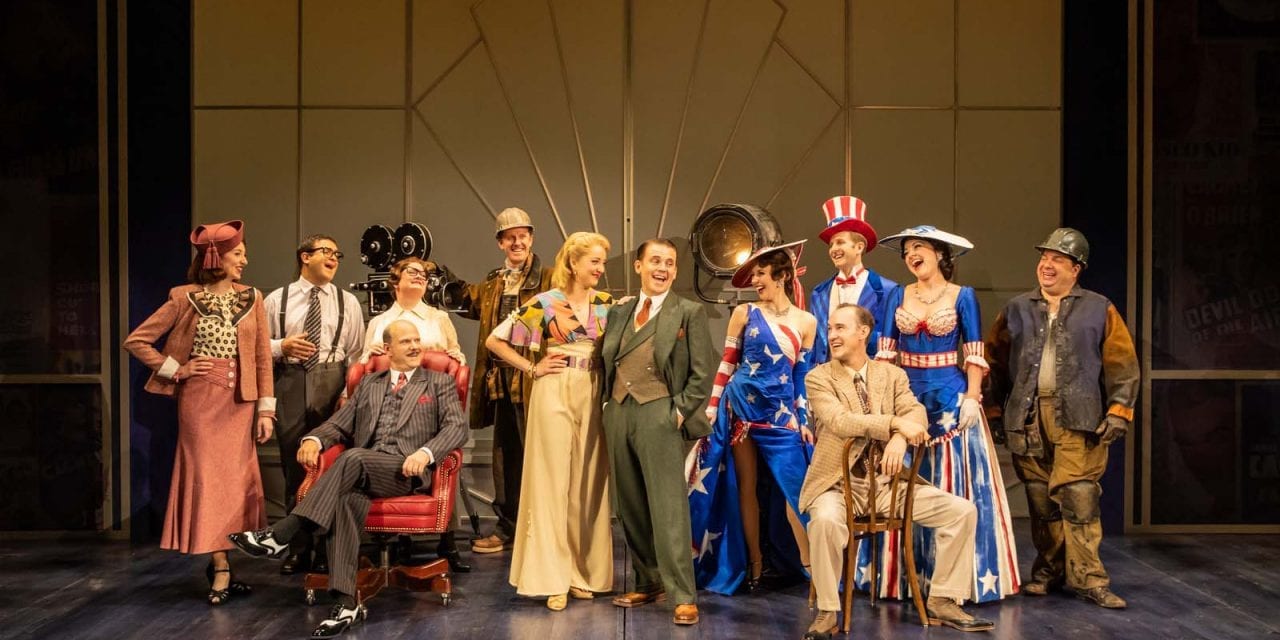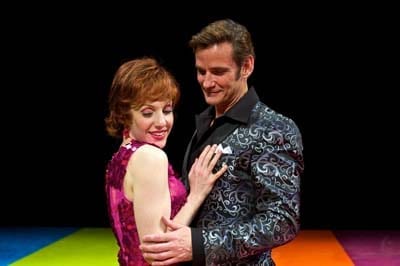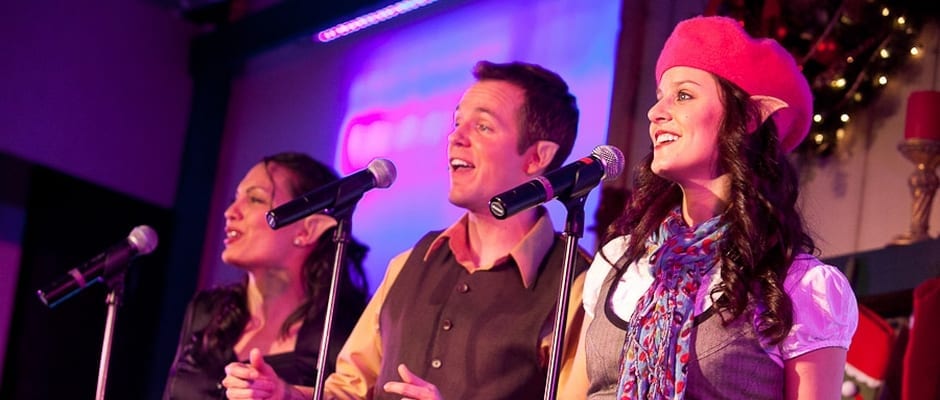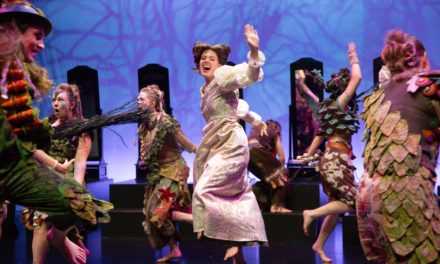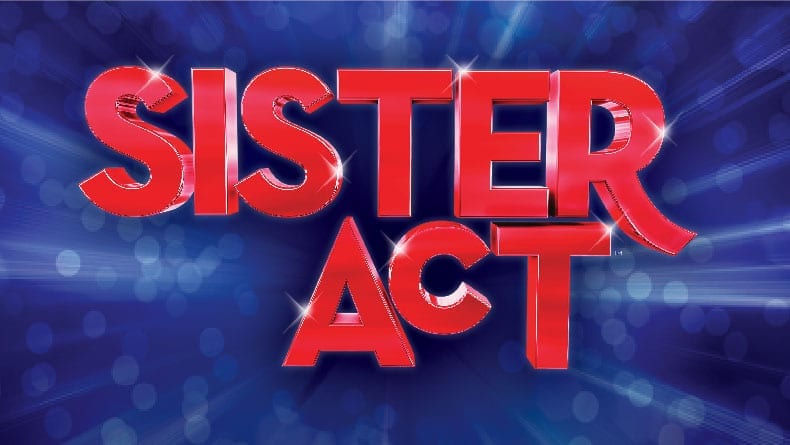SALT LAKE CITY — Based on a book by Peter Colley, Cagney, playing now at Pioneer Theatre Company, is a show whose creators’ Broadway hopes are too high. Directed by Bill Castellino, this musical tells the story of James Cagney, a vaudeville legend and dancer that appeared both on Broadway and in full-length feature films. Though the story is, at points, interesting, the way this story was told was fairly cumbersome — and many of the plot points seemed to simply be excuses for performers to wear their tap shoes.

Show closes October 5, 2019.
The set, designed by James Noone, was appropriate for the production: simple, geometric, and versatile.Mostly black with silver accents, the design was very reminiscent of the 2013 Great Gatsby film, minus the glimmering gold (in other words, it did not feel very original). Various props and furniture pieces would glide in and out of the stage to create new spaces with the plain, dark backdrop, such as a desk or a set of armchairs. The most clever piece designed by Noone was at the top center of the stage, being an old-fashioned “now playing” movie theater sign, with words projected on it to tell the audience where each scene was taking place.
Like the projection, the lights and shadows definitely outshone the unsophisticated set. The projection design by Brad Peterson gave the set some character of its own, providing the real backgrounds for particular scenes. These projections even included details such as the “WB” logo representing Warner Brother Studios, where Cagney would work for a large portion of his life. Lighting designer Paul Miller emphasized these excellent projections by shining appropriate lights where needed, even casting the shadows of performers onto the projection, giving the effect that it was not a projection at all.

Left to right: Robert Creighton as James Cagney and Darrin Baker as Jack Warner.
One example of the great work of Peterson being complemented by lighting designer Miller occurred at the start of the second act, at a Senate committee hearing. The committee members danced around Cagney, questioning his potential communist beliefs and sympathies, all the while casting tall shadows on the back wall — some as projections, and others natural from their movements emphasized by light. These gargantuan silhouettes gave the foreboding feeling that Cagney was in serious trouble, and in a state of mind wherein the Red Scare could potentially ruin his career.
Because Cagney‘s story does not require much extravagance when it comes to costume, hair, and makeup design, there is only one scene that I felt particularly impressed by. At the conclusion of Act I, the classic song “Grand Old Flag” was performed. Costume designer Gregory Gale decked out the company of actors and actresses in anything and everything patriotic: reds, white, blues, and even eagle feathers. One actress even held up a torch reminiscent of Lady Liberty. Hair and makeup by Amanda French perfectly suited the scene and complemented the “grand” wardrobe.
Colley’s plodding script had the additional difficulty of an unclear structure. It was hard to understand the concept that an elderly James Cagney and his former associate James Warner were retelling the life story of James Cagney at a SAG Awards Ceremony until the third time we were whipped back to that scene. The flashbacks and scene changes did not feel natural at all, and most scenes had no introduction, aside from an address or location name projected onto the sign above the stage. For example, an early scene change from the Cagney home to Keith’s Music Theatre felt abrupt and random. Maybe a more refined script could have helped to ease these transitions.

Some of the cast of Cagney.
I also couldn’t tell if the show was supposed to be a comedy, a romance, or a history. None of these terms seem to be an appropriate descriptor. The comedic points were often presented in a vaudevillian fashion as an aside from the production itself, and the jokes that were told made me cringe more than laugh. There also was not much romance, aside from a song or two about the subplot of Cagney falling in love. And if Cagney is supposed to be a historical production, it was too unfocused to work as a staged biographical sketch.
Some scenes in the story also felt irrelevant, such as the many times the audience visited the Warner Brothers Studios just to see how James Warner interacted with his employees. After the first scene, it is clear that James Warner was a selfish, uncaring man. Seeing his daily tasks repeatedly did not help to move the production along. Other scenes, such as the “Grand Old Flag” or “The Camp Elliott Show” felt that they were only an excuse to put on another dance routine. Though a part of Cagney’s life and highly enjoyable, they also did not add anything to the show or provide insight into the man’s life.

Robert Creighton as James Cagney.
This being said, I am personally glad that so many dance numbers were justified, though on poor terms of justification. Choreographer Joshua Bergasse is obviously talented and experienced, and he was superb at loading the second half of the musical with stunning performance after stunning performance. The swings, lifts, and flips all showed off the talent of the cast as well, but anytime tap dancing took place on stage, the scene became an unmistakable crowd favorite. I do wish that more tap was included during the first half of the production.
Bergasse also used tap dancing creatively to enhance the humdrum story. When movie writers took their seats on stage, rather than having actual typewriters in front of them, the sounds belonging to their imaginary typewriters were made completely and brilliantly by the tapping of their feet. Bergasse’s choreography was one of the few redeeming qualities of Cagney.

Darrin Baker as Jack Warner and Darien Crago as Jane.
The music and lyrics by Robert Creighton and Christopher McGovern were lackluster. They did move the story along in a musical fashion (rather than through dialogue alone), but I cannot see many of them becoming Broadway hits. The songs I most enjoyed were “Grand Old Flag” (which was written by George M. Cohan and incorporated into Cagney) and “Fallin’ in Love.” “Grand Old Flag” was a classic, and “Fallin’ in Love” was filled with hilarious innuendos that paired humorously with the love story of Cagney and his dance partner.
As far as the performers go, none was subpar. James Cagney was played by Robert Creighton, and his short height only made him fit the role better. Creighton portrayed the Irish boxer-turned-dancer, expressing a wide range of emotions throughout the production. Through facial expressions, body language, and inflections in his voice, Creighton convinced me that he had, in essence, become James Cagney — and that he was the star of the show, no matter the content of the scene. And this does not even begin to describe the fantastic aptitude of Creighton’s tap dancing abilities.
Darrin Baker played Jack Warner, the head honcho of Warner Brothers Studios in California. As previously referred to, the very first time Baker was on stage, his character was dislikeable. This is a real sign that Baker is a first-rate actor, being able to persuade the audience that he was the “bad guy” in the life of James Cagney. The character answered his phone countless times by saying something to the effect of, “Jack Warner, make me happy!” and Baker was able to convincingly play the part of a self-centered Hollywood executive.
Darien Crago played multiple characters during the show, but her portrayal of Jane (Jack Warner’s secretary) was absolutely wonderful. Crago showed in every way possible that she had a crush on Mr. Warner, and almost every sentence he began she was ready to finish with an expression of undying love. Crago provided much needed comedic moments simply through her gestures, movements, and tones that picked up where the script was lacking.
Every performer on the Pioneer Theatre stage at any time was able to tap dance and stay in sync without missing a beat, and the group numbers were absolutely arresting. Though each actor and actress is not individually mentioned in this review, I applaud them all.
Perhaps if I was more familiar with the real life of James Cagney and his work in Hollywood, I would have enjoyed this musical more. Because this story seems to cater to a niche audience of Cagney enthusiasts, I do not believe that it would have any sort of highly successful run on Broadway—especially when considering the rising generation of Broadway audiences. I would definitely pay to see the incredible tap dancing performances, but I wouldn’t waste my money seeing the slow-moving, uninteresting story of an unfamiliar, forgotten movie star.

This review generously sponsored by a grant from the Salt Lake County Zoo, Arts, and Parks program.

